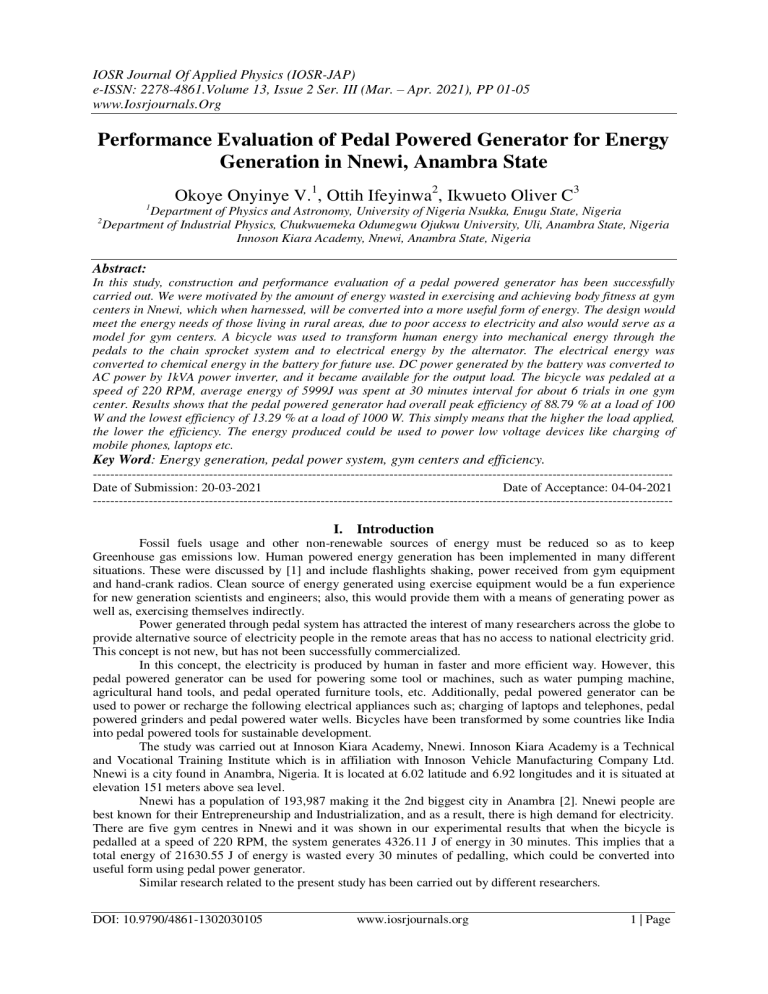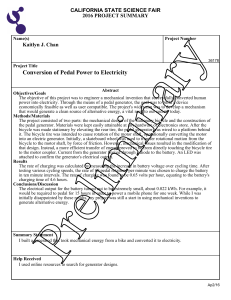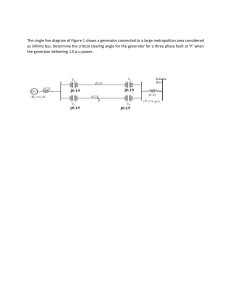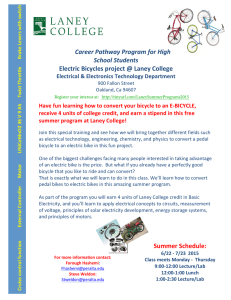
IOSR Journal Of Applied Physics (IOSR-JAP) e-ISSN: 2278-4861.Volume 13, Issue 2 Ser. III (Mar. – Apr. 2021), PP 01-05 www.Iosrjournals.Org Performance Evaluation of Pedal Powered Generator for Energy Generation in Nnewi, Anambra State 1 2 Okoye Onyinye V.1, Ottih Ifeyinwa2, Ikwueto Oliver C3 Department of Physics and Astronomy, University of Nigeria Nsukka, Enugu State, Nigeria Department of Industrial Physics, Chukwuemeka Odumegwu Ojukwu University, Uli, Anambra State, Nigeria Innoson Kiara Academy, Nnewi, Anambra State, Nigeria Abstract: In this study, construction and performance evaluation of a pedal powered generator has been successfully carried out. We were motivated by the amount of energy wasted in exercising and achieving body fitness at gym centers in Nnewi, which when harnessed, will be converted into a more useful form of energy. The design would meet the energy needs of those living in rural areas, due to poor access to electricity and also would serve as a model for gym centers. A bicycle was used to transform human energy into mechanical energy through the pedals to the chain sprocket system and to electrical energy by the alternator. The electrical energy was converted to chemical energy in the battery for future use. DC power generated by the battery was converted to AC power by 1kVA power inverter, and it became available for the output load. The bicycle was pedaled at a speed of 220 RPM, average energy of 5999J was spent at 30 minutes interval for about 6 trials in one gym center. Results shows that the pedal powered generator had overall peak efficiency of 88.79 % at a load of 100 W and the lowest efficiency of 13.29 % at a load of 1000 W. This simply means that the higher the load applied, the lower the efficiency. The energy produced could be used to power low voltage devices like charging of mobile phones, laptops etc. Key Word: Energy generation, pedal power system, gym centers and efficiency. --------------------------------------------------------------------------------------------------------------------------------------Date of Submission: 20-03-2021 Date of Acceptance: 04-04-2021 --------------------------------------------------------------------------------------------------------------------------------------- I. Introduction Fossil fuels usage and other non-renewable sources of energy must be reduced so as to keep Greenhouse gas emissions low. Human powered energy generation has been implemented in many different situations. These were discussed by [1] and include flashlights shaking, power received from gym equipment and hand-crank radios. Clean source of energy generated using exercise equipment would be a fun experience for new generation scientists and engineers; also, this would provide them with a means of generating power as well as, exercising themselves indirectly. Power generated through pedal system has attracted the interest of many researchers across the globe to provide alternative source of electricity people in the remote areas that has no access to national electricity grid. This concept is not new, but has not been successfully commercialized. In this concept, the electricity is produced by human in faster and more efficient way. However, this pedal powered generator can be used for powering some tool or machines, such as water pumping machine, agricultural hand tools, and pedal operated furniture tools, etc. Additionally, pedal powered generator can be used to power or recharge the following electrical appliances such as; charging of laptops and telephones, pedal powered grinders and pedal powered water wells. Bicycles have been transformed by some countries like India into pedal powered tools for sustainable development. The study was carried out at Innoson Kiara Academy, Nnewi. Innoson Kiara Academy is a Technical and Vocational Training Institute which is in affiliation with Innoson Vehicle Manufacturing Company Ltd. Nnewi is a city found in Anambra, Nigeria. It is located at 6.02 latitude and 6.92 longitudes and it is situated at elevation 151 meters above sea level. Nnewi has a population of 193,987 making it the 2nd biggest city in Anambra [2]. Nnewi people are best known for their Entrepreneurship and Industrialization, and as a result, there is high demand for electricity. There are five gym centres in Nnewi and it was shown in our experimental results that when the bicycle is pedalled at a speed of 220 RPM, the system generates 4326.11 J of energy in 30 minutes. This implies that a total energy of 21630.55 J of energy is wasted every 30 minutes of pedalling, which could be converted into useful form using pedal power generator. Similar research related to the present study has been carried out by different researchers. DOI: 10.9790/4861-1302030105 www.iosrjournals.org 1 | Page Performance Evaluation of Pedal Powered Generator for Energy Generation in Nnewi, Anambra State [3] carried out a study on design and fabrication of a pedal power generator. The aim of the design was to solve energy problems of those living in rural areas, due to poor access to electricity and also as a model for gym centers and cycle workout studios. The features of this design include; its simplicity, affordability, durability and easy to maintenance. Also, about 80 % of the materials used in fabricating the device were locally sourced. Their Results show that, human foot motion, less than 60 rpm was transferred via a treadle and sprocket-chain mechanism to drive a 24 V DC permanent magnet generator. Also, it was found that a voltage of 15 V and 2.5 A of current was produced at a speed of 483 rpm. The overall efficiency recorded was about 66.6 %. In another research, [4], studied power generation using bicycle mechanism as an alternative energy source. He concluded that, Power generated by pedaling is capable of converting mechanical to electrical energy, using either alternator or dynamo. [5] investigates the design and manufacturing of a pedal powered generator for electricity generation. He pointed out that, the device could serve as useful electricity source for a small family where the family members themselves can charge the battery by paddling for a short period of time each. II. Material And Methods MATERIALS USED The following materials were used in this design: i. Bicycle The first component that was really needed was the bicycle. The bicycle was used as the main source of energy, while the human occupant served as the bicycle prime mover. As the bicycle was pedaled, the chemical energy from the rider was converted into mechanical energy, and then was converted into electrical energy by the car alternator. i. Car Alternator. The car alternator connected to the rear bicycle hub using pulley – belt arrangement, produced electric current when the bicycle was pedaled at a reasonable speed. The role of the alternator in this design was to charge the battery. ii. Car Battery The car battery used in this design was 75 Ah, which performed the role of storing the electrical charges generated by the alternator. iii. Belt Pulley System for Speed Transmission In this design, the Belt - Pulley system was used to link the bicycle to the alternator, for proper transmission of motion between the two. iv. Indicator System An indicator system was used in this design to determine the level of charge in the battery. v. Tachometer Tachometer was used to measure the speed (RPM) of the pedal power generator system. vi. Multimeters Two multimeters were used in this project to measure the generated current and voltage during the experiment. vii. Power Inverter In our construction, a power inverter of I KVA was used to convert the Direct Current stored in the battery to an Alternating current in order to power home electronic appliances. METHOD USED In this work, methodology involved: Designing and fabricating the bicycle/alternator support frame using a mild - steel square pipe. Dismantling of the two bicycle tires in order to suit the design. Assembling the bicycle frame and alternator into the fabricated support frame. Connecting other components of the pedal power generator system such as; the battery and the inverter, as well as, the measuring tools (multimeters and tachometer). Taking the measurement of current and voltage as the bicycle was being pedalled. Studying the generated current, voltage, power and efficiency. Analysing, interpreting and comparing the different results recorded during the experimental testing. Figure 1 and pictures below shows a block diagram and the experimental setup of pedal powered generator system, with the components well assembled. DOI: 10.9790/4861-1302030105 www.iosrjournals.org 2 | Page Performance Evaluation of Pedal Powered Generator for Energy Generation in Nnewi, Anambra State Fig.1: Block Diagram of a 1 KVA Pedal powered Generation System Fig. 2: Picture of the Experimental Battery Charging System III. Results and Discussions Haven performed the experiment on the pedal powered generator; the following results were obtained and tabulated. Table 1: Variation of Output Characteristics without Load Generated Voltage (V) Generated Current (Amp) 1.50 1.90 2.00 2.40 5.00 2.90 5.30 Generated Power (W) Load (W) Output Voltage (V) Output Current (A) Output Power (W) Efficiency (%) 2.85 0 220 0 0 0 4.80 0 230 0 0 0 14.50 0 225 0 0 0 5.20 27.56 0 220 0 0 0 5.50 6.70 20.35 0 230 0 0 0 6.00 7.90 25.40 0 225 0 0 0 6.20 7.90 42.78 0 227 0 0 0 6.40 7.97 46.08 0 226 0 0 0 6.80 9.50 64.60 0 230 0 0 0 7.30 9.90 65.57 0 220 0 0 0 7.00 11.20 78.40 0 222 0 0 0 7.50 13.30 99.75 0 230 0 0 0 7.10 13.22 85.91 0 228 0 0 0 7.80 13.20 102.96 0 225 0 0 0 9.10 9.80 89.18 0 220 0 0 0 10.70 6.30 67.41 0 230 0 0 0 DOI: 10.9790/4861-1302030105 www.iosrjournals.org 3 | Page Performance Evaluation of Pedal Powered Generator for Energy Generation in Nnewi, Anambra State 9.40 2.50 23.50 0 230 0 0 0 9.90 7.20 71.28 0 226 0 0 0 10.20 9.50 96.90 0 229 0 0 0 10.40 9.90 97.36 0 225 0 0 0 9.80 11.20 109.76 0 220 0 0 0 12.90 13.30 171.57 0 230 0 0 0 12.44 12.10 150.52 0 225 0 0 0 13.62 13.20 179.78 0 228 0 0 0 13.61 9.80 133.38 0 230 0 0 0 13.42 6.30 84.546 0 225 0 0 0 13.80 2.50 34.5 0 230 0 0 0 Table 1 shows variation of Output characteristics of the Pedal powered generator without load. It was observed that when there was no load connected to the inverter, there was no flow of current and output power became zero. Consequently, the efficiency of the system was zero. Table 2: Variation of Output Characteristics without Load of 0 W – 1000 W Load (W) Trials Input Voltage (V) Output Voltage (V) Input Current (A) Output Current (A) Input Power (W) Output Power (W) Efficiency (%) 1 0 12.66 225.00 0.00 0.00 0.00 0.00 0.00 2 100 12.61 218.00 7.63 0.39 96.21 85.02 88.37 3 200 12.64 200.80 7.61 0.42 96.19 84.34 87.68 4 300 12.80 188.00 7.08 0.41 90.62 77.08 85.05 5 400 12.01 153.70 7.54 0.48 90.56 73.78 81.47 6 500 12.72 144.70 7.12 0.44 90.57 63.67 70.29 7 600 12.48 131.10 6.75 0.36 84.24 47.19 56.03 8 700 12.70 92.95 5.28 0.29 67.06 26.96 40.19 9 800 12.38 43.92 4.55 0.24 56.33 10.54 18.71 10 900 12.35 27.27 3.53 0.21 43.59 5.73 13.14 11 1000 11.68 28.23 2.40 0.13 28.03 3.67 13.09 DOI: 10.9790/4861-1302030105 www.iosrjournals.org 4 | Page Performance Evaluation of Pedal Powered Generator for Energy Generation in Nnewi, Anambra State Table 2 shows results of the performance of 1KVA Pedal Powered generating system when different capacities of loads were connected. The result revealed the relationship between voltage, current, power and efficiency at both generated and output level. Figure 2 (a and b), shows the variation of output power and efficiency with different capacities of loads connected. The principle of the higher the load, the lower the efficiency which was also confirmed by (Adarsh, 2014) was shown. It was clearly shown that the power of the pedal generator decreased with increase in load capacity applied. The maximum and minimum values of output power were 85.02 W and 3.67 W respectively, and these were obtained when the load capacity of 100 W and 1000 W were connected. Also, efficiency of the system decreased with increase in the load capacity applied. The peak efficiency of 88.37 % was recorded at a load of 100 W and the lowest efficiency of 13.09 % at loads of 1000 W was also recorded. The lowest efficiency obtained was as a result of a high load capacity connected to the generator. However, it can be deduced that, to operate the 1 KVA Pedal Powered Generator more efficiently, the maximum load to be connected must be below 600 watts. IV. Conclusion Pedal Power generator has been fabricated and tested. This generator was able to convert human power into electricity through the means of a pedaling of a stationary Bicycle. Based on the Experiment and Analysis performed, the following conclusions were made: The findings on the analysis of the generator characteristics with speed revealed that, as the pedaling speed increased, the generated current, voltage and power also increased. It was observed from Table 2 that when a load of 100 W was connected to the generator, the output power and efficiency of the generator decreased as time progressed. This was because, the battery discharged with time of usage. Figure 2a and 2b revealed that, the more the load, the less the efficiency and output power of the pedal power generator. Consequently, to operate a 1 KVA pedal power generator more efficiently, the load must not exceed 600 Watts. This innovation can be mass produced to serve people living in the rural areas, as it will enable them to power loads of lower capacities, such as; charging of phones, laptops, torches, among others. Some of the factors considered during this design include; the safety and comfort of the users. References [1]. [2]. [3]. [4]. [5]. [6]. William, V. and Jeffery, H. (2012) Human Powered Generation- Seesaw, Senior Project, Department of Electrical Engineering, California Polytechnic State University. Orjiakor J.C. & Igbokwe J.I. (2019). Application of Remote sensing and Multimedia Geographic System (GIS) in Administration of Socio Economic Activities in Nnewi Urban Area of Anambra State, Nigeria. Environmental Research Journal, 3 (2): 60 – 67. Anyanwu S., Ashinze E. and Anthony E. (2016). Design and Fabrication of a Pedal Operated Power Generator, Innovative Systems Design and Engineering, 7(3), 55 – 71. Manish S. Y., Ajey K. T., Mohd A., Rahul K., Arun N., Dhruv K. & Ashutosh S. (2018). Power Generation Using Bicycle Mechanism as an Alternative Energy Source. International Research Journal of Engineering and Technology (IRJET), 5(4), 234 – 241. Kris, D. (2011) The Short History of Early Pedal-powered Machines, LowTechMagazine.http//:www.lowtechmagazine.com/2011/05/history-of pedal-powered-machines.html. Adarsh R., Kushagra S., Sudeep M. (2014). “Pedal Powered Washing Machine”, International Journal of Scientific and TechnologyResearch (IJSTR), 3(11), 97-103. Okoye Onyinye V, et. al. “Performance Evaluation of Pedal Powered Generator for Energy Generation in Nnewi, Anambra State.” IOSR Journal of Applied Physics (IOSR-JAP), 13(2), 2021, pp. 01-05. DOI: 10.9790/4861-1302030105 www.iosrjournals.org 5 | Page






